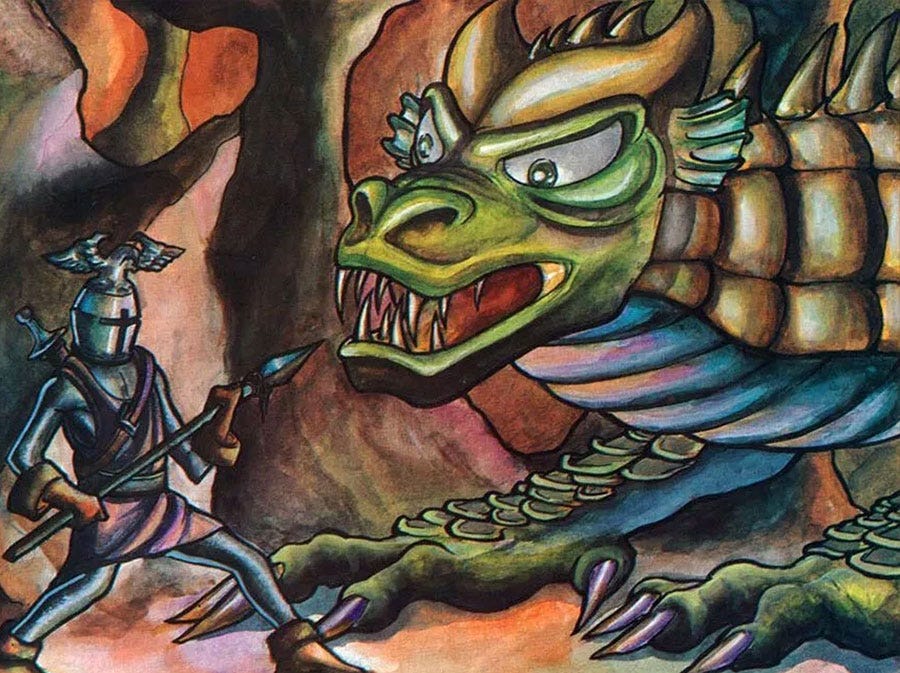Erol Otus – Dungeons & Dragons Artist
Erol Otus’ art on early Dungeons & Dragons product is iconic. Like many of the standout artists who worked on the game during this time, it was because Otus had a unique style. Otus’ long lither figures, smooth skin and cosmic craziness evoke other-worldliness. His style here was not the standard high fantasy, it was dark and esoteric. Taking game elements in fantasy directions that player’s and DMs would have hard time conceiving on their own.
Otus first connected with Dungeons & Dragons as a player in the Seventies. He was self-taught at this point, he would only take on more formal training as an artist after leaving TSR. Then he would study painting and illustration at UC Berkeley and the Academy of Art in San Francisco.
Being a burgeoning artist he began submitting fantasy illustrations to TSR for consideration. It didn’t take long for TSR to take notice of his talent and in 1976 Gary Gygax used one of his color pieces as the basis for the Remorhaz in The Dragon #2. His next big piece would be for the Anhkheg in The Dragon #5 that same year. While Otus got his start in The Dragon, he would only grace the cover of a single issue, #55.
That cover of #55 is a perfect example of Otus doing the unexpected. I have no idea what that creature is supposed to be, but it both humorous and terrible at the same time. You just can’t stop staring at it. It was one of my favorite covers from when I was a kid because of that.
When TSR was looking to hire a full-time staff artist, they gave Otus a call and he went to work for the fledgling company in their Lake Geneva, WI headquarters. Once a full time employee, Otus created some of the most iconic works of Dungeons & Dragons.
Boxed Set
Otus would provide the cover art and many internal illustrations for the original Dungeons & Dragons Basic and Experts sets. These iconic rule sets were many people’s introduction to the game.
Advanced Dungeons & Dragons
Otus illustrations would grace many Advanced Dungeons & Dragons products, but he is probably most famous for his contribution to the Deities and Demigods. He not only illustrated the cover, but also the controversial Cthulhu Mythos, which would be removed in later editions.
Some of my favorite AD&D work of his was in the 1982 Monster Cards series. When you compare his work there to other popular illustrations of monsters in the game, his style really stands out
Otus has the ability to make things both beautiful and monstrous at the same time. His art for even non-fantasy creatures takes on an uncanny quality. This fires the imagination and gives as much character to his Constrictor Snake as his depiction of a Ghoul.
Modules
If you have ever stared at art in a module and thought, where is this place, why does it look like another world? You are probably seeing Otus’ work. He has many credits, but some great works of his appear in legendary adventures like, The Keep on the Borderlands (B1) and Vault of the Drow (D3).
Non Dungeons & Dragons
It is probably not surprising to hear that Otus worked outside of the fantasy world where he got his big break. He would work in video games, on games like Star Control 2 and Star Trek: Generations, The Last Ninja and Skylanders, Otus has spread his wings in the gaming industry doing both writing and voice work.
While he might not do work for Wizards of the Coast, Otus keeps has worked with other pen an paper companies like Goodman Games and Oracle Games.
Conclusion
Otus is my perfect kind of artist. Talented and a bit enigmatic, he appears to dance to his own beat. Which is why he is one of the perfect people to come along and help breath creative visual life into this most wonderful of RPGs.
Otus does not give many interviews, but if you want to learn more about him, please check out this amazing interview with Matt Staggs.



